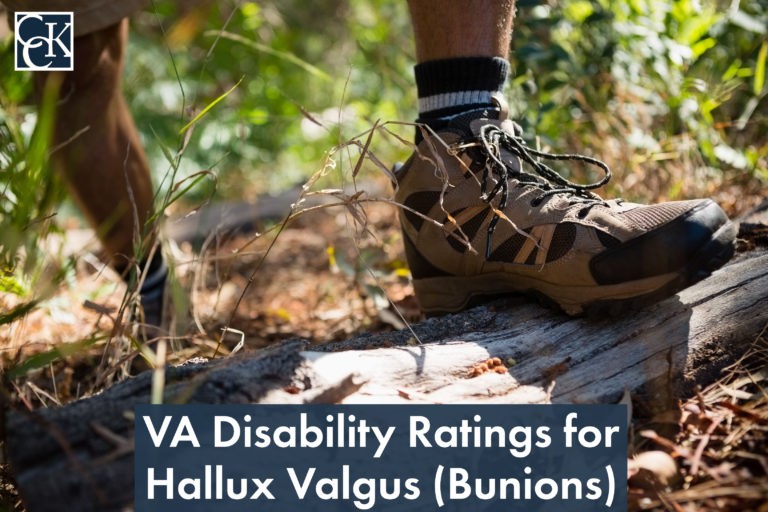VA Disability Ratings for Hallux Valgus (Bunions)

CCK Law: Our Vital Role in Veterans Law
What is Hallux Valgus (Bunions)?
Hallux Valgus, otherwise known as bunions, are a bony bump that forms on the joint at the base of the big toe. Typically, bunions occur when some of the bones in the front part of the foot move out of place. This process then causes the tip of the big toe to be pulled toward the smaller toes and forces the joint at the base of the big toes to stick out.
Oftentimes, the skin surrounding the bunion will be red and sore. Certain behaviors, such as wearing tight, narrow shoes, may exacerbate bunions. In some cases, bunions may also develop as a result of the shape of an individual’s foot, a foot deformity, or a medical condition (e.g., arthritis). When smaller bunions form on the joint of the little toe, they are referred to as bunionettes.
Signs, Symptoms, and Causes
Common signs and symptoms of bunions include the following:
- A bulging bump on the outside of the base of an individual’s big toe
- Swelling, redness, or soreness around the big toe joint
- Corns or calluses – these often develop where the first and second toes rub against each other
- Ongoing pain or pain that comes and goes
- Limited movement of the big toe
There are many potential causes for bunions, including factors such as inherited foot type, foot stress or injuries, and deformities present at birth. Footwear may also contribute to the formation of bunions. Specifically, too narrow or ill-fitting shoes can cause bunions.
To help prevent bunions, health care providers suggest that individuals choose shoes carefully. In particular, shoes should have a wide toe box and there should be space between the tip of the longest toe and the end of the shoe.
To diagnose bunions, doctors will typically begin by examining the foot and identifying where the bunions are located. After a physical exam, an X-ray of the foot can help doctors determine the best way to treat the bunions. Treatment options tend to vary depending on the severity of the bunion and how much pain it causes. Nonsurgical treatments can include the following:
- Changing shoes
- Padding – bunion pads or cushions can act as a buffer between the foot and the shoe to ease pain
- Medications
- Cortisone injections
- Shoe inserts – can help distribute pressure evenly when moving the feet
- Applying ice
If the treatment options outlined above do not relieve symptoms, surgery may be required; however, surgery should only take place when a bunion causes frequent pain or interferes with activities of daily living.
Surgical procedures for bunions can be done as single procedures or in combination. They might involve the following: removing the swollen tissue from around the big toe joint; straightening the big toe by removing part of the bone; realigning one or more bones in the forefoot to a more normal position to correct the abnormal angle in the big toe joint; joining the bones of the affected joint permanently.

Service Connection for Hallux Valgus (Bunions)
Prior to receiving disability compensation from VA, veterans must prove that their disability is related to service. Generally, to establish direct service connection you must have a current, diagnosed disability; however, you can sometimes argue that broader symptoms resulting in impairment also warrant service connection even if there is no actual diagnosis.
The next step in establishing direct service connection for bunions involves demonstrating the occurrence of an in-service event or injury. The final component requires a medical nexus, or link, between the in-service event and the current disability. If all three of the above-mentioned elements are met, VA should award service connection for bunions and then assign a disability rating.
Compensation & Pension (C&P) Examinations for Bunions
As mentioned above, service connection generally requires a medical nexus between a veteran’s disability and in-service event. VA is more often than not going to order a C&P examination as long as there is some suggestion that the veteran’s bunions are related to service. The VA examiner is going to focus on whether they believe the veteran’s bunions are due to their time in service.
Following the examination, the VA examiner will issue a favorable opinion that supports service connection or an unfavorable opinion that does not. It is important for veterans to ask for a copy of the C&P examination. VA is required to give veterans a copy upon request but will not otherwise provide one. If a veteran disagrees with the VA examiner’s opinion regarding service connection, they can obtain an opinion from a private physician or treating doctor outside of VA and argue against the original examiner’s conclusions.
Within the C&P examination, the VA examiner will also determine the severity of the veteran’s symptoms. If service connection is granted, VA adjudicators will then assign a disability rating consistent with the examiner’s findings.
How Does VA Rate Hallux Valgus (Bunions)?
Generally speaking, VA rates bunions according to 38 CFR § 4.71a, Schedule of Ratings – Musculoskeletal System, Diagnostic Code 5280. The rating criteria are as follows:
- 10% – operated with resection of metatarsal head
- 10% – severe, if equivalent to amputation of great toe
Importantly, a veteran with multiple diagnosed foot conditions (e.g., bunions and pes planus), might only receive one disability rating under one diagnostic code if some of the symptoms of one diagnosis overlap with symptoms of the other. In other words, pyramiding – the VA term for rating the same disability, or same symptoms of a disability, twice – is not allowed. This rule prevents veterans from being compensated for the same symptom twice. However, if the diagnosed foot conditions manifest in different ways, it is possible they will be rated separately.
About the Author
Share this Post

